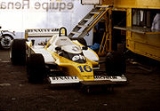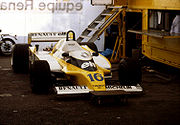
Renault RS10
Encyclopedia
The Renault RS10 was a Formula 1 car developed to compete in the 1979 Formula One season
, which become the first turbocharged F1 car to win a Grand Prix
. This changed the framework of F1 as this car spurred the development of the 1500 bhp turbocharged cars of the 1980s and rang the death knell for normally aspirated engines. This car, along with its predecessor, the Renault RS01
, was one of the most revolutionary Grand Prix cars of all time.
 The RS10 was designed and developed by François Castaing, Michel Tétu and Marcel Hubert and was developed from the much maligned RS01. The RS01 was conceived alongside Renault's effort to build a turbocharged Le Mans winning car. The RS01 was no more than a development mule for the 1.5-litre turbocharged engine.
The RS10 was designed and developed by François Castaing, Michel Tétu and Marcel Hubert and was developed from the much maligned RS01. The RS01 was conceived alongside Renault's effort to build a turbocharged Le Mans winning car. The RS01 was no more than a development mule for the 1.5-litre turbocharged engine.
Jean-Pierre Jabouille
with his engineering degree, mechanical aptitude and driving skill was hired to run Renault's F1 program in 1977. Jabouille worked to develop this engine over the 1977-1979 seasons. The Renault turbo effort was a joke along the paddock as the RS01 earned the moniker "Yellow Teapot" as its race would often end with the yellow car smoking and parked. It would not be long however, before the jokes and laughs along the grid turned to panic.
The RS10 was finally built in 1979 as a serious contender with a Renault Gordini twin-turbo 1.5-litre V6. Where the RS10 differed from the RS01, however, was that it incorporated twin-turbochargers, a 6-speed transmission and a completely new ground effect chassis.
. Though reliability issues still plagued the new twin-turbo, its pace made the paddock finally take notice. Through the final eight races of the season the RS10 scored five poles and one memorable home win at the 1979 French Grand Prix
at Dijon-Prenois
. More wins would surely have followed if not for the engine troubles. Jabouille in particular saw his hard work hardly rewarded thanks to the new engine technology. His win in Dijon though, in front of home fans with an all French car, engine, tyres and even French fuel (Elf), was his prize for three hard years of no results.
As ground effects were perfected and the turbos started boasting 1500 bhp, deadly crashes ensued. This led to turbos being banned in 1989. Pioneers Renault never won a championship having this technology, though they did manage two runner-up positions. Conclusively, their vision in the late 1970s sparked a new era in Formula 1.
1979 Formula One season
The 1979 Formula One season was the 30th season of FIA Formula One motor racing. It featured the 1979 World Championship of F1 Drivers and the 1979 International Cup for F1 Constructors which were contested concurrently over a fifteen round series which commenced on January 21, 1979, and ended on...
, which become the first turbocharged F1 car to win a Grand Prix
1979 French Grand Prix
The 1979 French Grand Prix was a Formula One race held on 1 July 1979 at Dijon.It marked the first victory of a turbocharged car in Formula One, with Renault overcoming the reliability problems that had initially plagued their car...
. This changed the framework of F1 as this car spurred the development of the 1500 bhp turbocharged cars of the 1980s and rang the death knell for normally aspirated engines. This car, along with its predecessor, the Renault RS01
Renault RS01
The Renault RS01 was the first F1 car to be powered by a turbocharged engine. Designed by André de Cortanze and Jean-Pierre Jabouille, it first appeared at the 1977 British Grand Prix. The rules of F1 at the time permitted 3.0 litre engines of natural aspiration, with a clause for a 1.5 litre...
, was one of the most revolutionary Grand Prix cars of all time.
Development

Jean-Pierre Jabouille
Jean-Pierre Jabouille
Jean-Pierre Alain Jabouille is a former racing driver from France.-Biography:A native of Paris, Jabouille was one of the last of a breed of Formula One drivers who were also engineers....
with his engineering degree, mechanical aptitude and driving skill was hired to run Renault's F1 program in 1977. Jabouille worked to develop this engine over the 1977-1979 seasons. The Renault turbo effort was a joke along the paddock as the RS01 earned the moniker "Yellow Teapot" as its race would often end with the yellow car smoking and parked. It would not be long however, before the jokes and laughs along the grid turned to panic.
The RS10 was finally built in 1979 as a serious contender with a Renault Gordini twin-turbo 1.5-litre V6. Where the RS10 differed from the RS01, however, was that it incorporated twin-turbochargers, a 6-speed transmission and a completely new ground effect chassis.
Racing history
The RS10 was introduced a third of the way through the 1979 season at the 1979 Monaco Grand Prix1979 Monaco Grand Prix
The 1979 Monaco Grand Prix was a Formula One race held on 27 May 1979 at Monaco.- Classification :- Notes :* Lap Leaders: Jody Scheckter 76 laps .* Last race - James Hunt-Standings after the race:Drivers' Championship standings...
. Though reliability issues still plagued the new twin-turbo, its pace made the paddock finally take notice. Through the final eight races of the season the RS10 scored five poles and one memorable home win at the 1979 French Grand Prix
1979 French Grand Prix
The 1979 French Grand Prix was a Formula One race held on 1 July 1979 at Dijon.It marked the first victory of a turbocharged car in Formula One, with Renault overcoming the reliability problems that had initially plagued their car...
at Dijon-Prenois
Dijon-Prenois
Dijon-Prenois is a motor racing circuit located in Prenois, near Dijon, France. The undulating track is noted for its fast, sweeping bends....
. More wins would surely have followed if not for the engine troubles. Jabouille in particular saw his hard work hardly rewarded thanks to the new engine technology. His win in Dijon though, in front of home fans with an all French car, engine, tyres and even French fuel (Elf), was his prize for three hard years of no results.
Future
The car and team that began as a joke quickly had the paddock scrambling. Ferrari and Brabham quickly put together a turbo program in the 80's. The other major manufactures did so as well as the turbo cars began to gain power and reliability. Soon all the major teams had forced-induction power. The smaller, mainly British teams lacked the funding to obtain this technology and their results suffered. The turbos became so disparagingly fast that FISA adopted a non turbo cup in 1987 known as the Jim Clark Cup.As ground effects were perfected and the turbos started boasting 1500 bhp, deadly crashes ensued. This led to turbos being banned in 1989. Pioneers Renault never won a championship having this technology, though they did manage two runner-up positions. Conclusively, their vision in the late 1970s sparked a new era in Formula 1.

